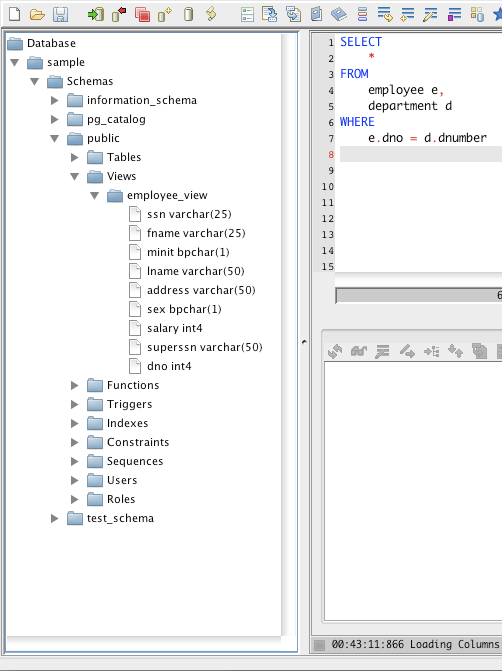
- #Razorsql versus dbviz postgresql pro#
- #Razorsql versus dbviz postgresql software#
- #Razorsql versus dbviz postgresql free#
Also confirm (I assume) that RazorSQL and DataStudio are pointing at exactly the same database and schema.
#Razorsql versus dbviz postgresql software#
However, you cannot specify the order using SQLite's group_concat function. Compare price, features, and reviews of the software side-by-side to make the best choice for your business. Edit your question to give more details, such as the SQL (presumably the same SQL for both GUI tools), the datatype of the columns ItemNumber and Description in Db2, and which Db2-server-platform (z/os, i-series, Linux/Unix/Windws). SELECT parent_name, group_concat(child_name, ' ') The syntax in SQLite is similar to MySQL: Group_concat(child_name ORDER BY child_name SEPARATOR ' ')

Modify the query appropriately, if you need a specific ordering or separator. Finally, you select rows where all children's names have been appended. Then, in the subquery children_grouped, you append each child's name one by one, separating the next name with a comma. SELECT rownumber() over(partition by parent_name),Ĭhildren_grouped (parent_name, list, idx) ASĬhildren_grouped.list || ', ' || children_numbered.child_name,Ĭhildren_grouped.parent_name = children_numbered.parent_nameĪND children_grouped.idx + 1 = children_numbered.rowNumįirst you number each person's children (subquery children_numbered). In DB2 there is no handy function which could be used, so you have to use the WITH query:Ĭhildren_numbered(rowNum, parent_name, child_name) AS SELECT parent_name, get_comma_separated_value(child_name) Return_text := return_text || ',' || x.col2
#Razorsql versus dbviz postgresql free#
Prior to version 11g, StackOverflow recommends that you use the function:įUNCTION get_comma_separated_value (input_val in number)įOR x IN (SELECT col2 FROM table_name WHERE col1 = input_val) LOOP DbVisualizer Free is a universal database tool that allows you to manage a wide range of databases including Oracle, Sybase, SQL Server, PostgreSQL, DB2, MySQL. ) clause is part of the LISTAGG function syntax so there's no way to concat strings without specifying the order. LISTAGG(child_name, ',') WITHIN GROUP (ORDER BY child_name) In Oracle from version 11g you can use the LISTAGG function. Powerful cross-platform utility designed to make it simple and fast to. SELECT parent_name, string_agg(child_name, ',') Prior to version 8.4, you would have had to define the function ARRAY_AGG before using it:įrom version 9.0 on, you can use the string_agg function: If you want to order the names in each group:ĪRRAY_TO_STRING(ARRAY_AGG(child_name ORDER BY child_name ASC), ',') The function ARRAY_AGG() returns an array of elements in the group, the function ARRAY_TO_STRING() concatenates the elemens in the array using the given separator. SELECT parent_name, ARRAY_TO_STRING(ARRAY_AGG(child_name), ',') In PostgreSQL you use ARRAY_TO_STRING() and ARRAY_AGG() functions: Let's take a look at how you can aggregate strings in a group in other databases. In most other databases, there is no GROUP_CONCAT() function. Group_concat(child_name ORDER BY child_name asc separator ' ') To make sure the names of the children in each string are alphabetically ordered and to use semicolon " " as a separator, use this query:

| parent_name | group_concat(child_name) | SELECT parent_name, group_concat(child_name) Support for exporting very large result.To get the names of children of each person as a comma-separated string, you use the GROUP_CONCAT() function as follows: Spreadsheet-like table data editor including binary/BLOB and CLOB data types, import from CSV and Excel files.Įxport database objects and table data as CREATE/INSERT statements, CSV, XML and more. Edit, compile and, run procedures, functions, triggers, and, a lot more. Multiple objects can be displayed side-by-side. Tree based navigation through database objects. SQL editor with support for auto completion, parameterized SQLs, SQL formatter, visual query builder, explain plan, and, a command-line based interface. It is the ultimate solution since the same tool can be used on all major operating systems accessing a wide range of databases.Īmazon Redshift, DB2 LUW, Exasol, H2, Informix, JavaDB/Derby, Microsoft SQL Server, Mimer SQL, MySQL, Netezza, NuoDB, Oracle, PostgreSQL, SQLite, Sybase ASE, and Vertica.
#Razorsql versus dbviz postgresql pro#
DbVisualizer Pro 13.0.3 (x86/圆4) | 176.9 MbĭbVisualizer is the universal database tool for developers, DBAs and analysts.


 0 kommentar(er)
0 kommentar(er)
